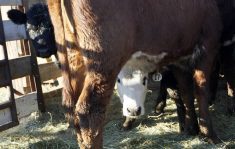RED DEER – Antimicrobial resistance is a complicated and growing public health issue because of possible links to antibiotic use in livestock.
“Resistance started as soon as antibiotics were commercialized about 50 years ago,” says Trevor Alexander of Agriculture Canada.
“We have found the use of antimicrobials for subclinical treatment do cause bacteria to become resistant.”
A pilot project to survey and monitor antimicrobial resistance started in four southern Alberta feedlots in 2007. It is hoped the results will lead to a long-term surveillance program, which other countries have already implemented for their commodity groups.
Read Also

Saskatchewan dairy farm breeds international champion
A Saskatchewan bred cow made history at the 2025 World Dairy Expo in Madison, Wisconsin, when she was named grand champion in the five-year-old Holstein class.
Alexander said studying the incidence of resistance contributes to balanced, science-based policy making.
“The demands for continued surveillance is due to public health concerns,” he told the recent Alberta Beef Industry Conference in Red Deer.
He said the increasing problem of antimicrobial resistance appears connected to practices within human rather than veterinary medicine.
People become concerned when products such as tetracycline, sulfonamides and ampicillin are used to promote growth or ward off possible disease, charging that overuse of these products could lead to resistance.
However, Alexander said producers do not want resistance problems either because it could mean losing valuable treatments.
There are two concerns:
- Limited treatment of infections if a pathogen is resistant to an antibiotic.
- Transfer of resistant genes to bacteria that do not normally cause problems, such as those found in the digestive tract. Resistant genes are transferred to other bacteria that are infectious, creating a reservoir of resistant genes that need to be controlled.
In agriculture, resistant bacteria can be found in water, manure, feed and infected animals.
An infected animal can shed the bacteria into the manure and infect others that eventually end up in the food chain.
Bacteria can survive 175 days in manure, so composting is recommended to control these pathogens.
A farm to fork study found resistant bacteria in animals that could possibly get into the food supply.
“The good thing was that animals that were or were not fed antimicrobials had the same incidence rate of resistant bacteria,” Alexander said.
This study looked at E. coli, salmonella and Mannheimia haemolytica, formerly called pasteurella haemolytica, which is implicated in bovine respiratory disease.
If researchers found M.haemolytica in nasal swab samples, they then also looked for E. coli and salmonella in the animals’ fecal samples.
The study collected 6,000 E. coli samples, and none were resistant to antibiotics.
Approximately 1,500 positive cases of M. haemolytica have been found while testing animals as they arrive and leave feedlots, which is 15 percent of the cattle in the study.
Most samples were susceptible to antibiotics, but seven percent were resistant to one antimicrobial.
“Treating animals with BRD with antibiotics is still effective,” Alexander said.
Development and spread of antimicrobial resistance in this disease appears to be low.
“If we can get a better understanding of what is happening with these bacteria, we can also introduce mitigation steps,” he said.















